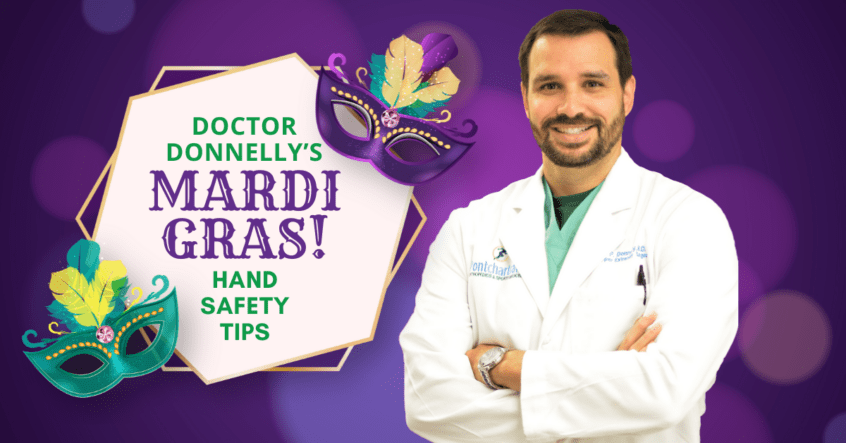
Mardi Gras Hand Injuries: What Next?
The hand and wrist are used in almost all sports, and during Mardi Gras, catching beads and scooping-up doubloons can seem like an Olympic event!
The hand, wrist and fingers are vulnerable to injuries in sports and at parades. In today’s post, we discuss how to determine if a stomped hand or fingers tangled in a bead tug-of-war require professional medical attention.
Who is at Risk of Mardi Gras Hand Injuries?
While a person of any age can experience serious mardi gras hand injuries, children and older adults are at higher risk, but for different reasons.
In children, most hand or wrist injuries occur during play or from accidental falls. During Mardi Gras, little fingers going after doubloons sometimes fall victim to a “stomp and drag” injury from a fellow reveler.
A child with an injury occurring at the end of a long bone near a joint may injure the growth plate (physis) and should be checked out by a professional.
Older adults are at a higher risk for injuries and fractures because they lose bone strength (osteopenia), and may have vision and/or balance problems This combination means a fall along the parade route could results in a serious hand or wrist injury.
Sudden (acute) Hand or Wrist Injury
An acute hand or wrist injury may occur from a direct impact, a fall, or from twisting, jerking, jamming, or bending abnormally. Pain from an acute hand or wrist condition may be sudden and severe.
Bruising and swelling may develop immediately after the injury. Acute hand or wrist injuries include:
- Bruises
- Ligament and tendon injuries
- Joint injuries (sprains)
- Pulled muscles (strains)
- Broken bones (fractures)
- Dislocations
Most minor injuries will heal on their own, and home treatment is usually all that is needed to relieve the pain and promote healing. However, what are the signs of the more serious Mardi Gras hand injuries?
How Serious is a "Serious" Hand Injury?
If someone steps on your fingers instead of beads, or you fall off a ladder and onto your hands, the resulting injury is going to hurt.
However, determining the severity of a more serious hand or wrist injury can be tricky. Should you experience any of the following, it's time to see a doctor:
- Severe pain
- Significant swelling within 30 minutes of the injury
- The injured finger or joint looks odd, is a strange shape, or is out of its normal position
- Signs of blood vessel or nerve damage, like numbness, tingling, or the feeling of pins-and-needles
- Skin turning white, or blue, or feels colder than the surrounding skin
- Unable to move hand, wrist or fingers normally
A delay in diagnosis and treatment of a hand or wrist injury can lead to poor healing, a decreased range of motion and decreased grip strength.
See a Hand, Wrist & Elbow Specialist
Dr. Donnelly and everyone at the office wish you and your family a happy and safe Mardi Gras! If you experience a hand, wrist or elbow injury this Mardi Gras, contact Dr. Donnelly's office today to learn more about your treatment options.
This site is not intended to and does not provide medical advice, professional diagnosis, opinion, treatment or services to you or to any other individual. Through this website and links to other websites, Brandon P. Donnelly, MD provides general information for educational purposes only. The content provided in this website and links, is not a substitute for medical care or treatment. You should not use this information in place of a consultation or the advice of your healthcare provider. Brandon P. Donnelly, MD is not liable or responsible for any advice, course of treatment, diagnosis or any other information, services or product you obtain through this site.

